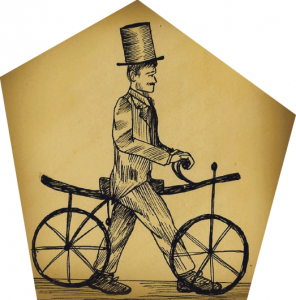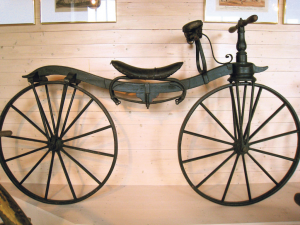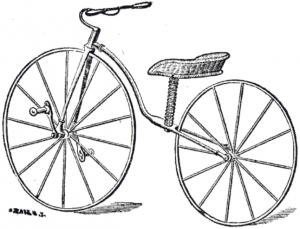FRIDAY, 25 JANUARY 2013
For centuries, inventors have searched for a swift carriage that frees man from relying on animals. In 1813, more than 70 years before the invention of the modern automobile, Karl von Drais, a forestmaster from Mannheim (in modern day Germany), built a four-wheeled vehicle seating up to four people and powered by winding cranks using arms and legs. Believing he had found the solution for human-powered transport, he felt confident to demonstrate it before state leaders assembled at the Congress of Vienna. Patent examiners were less impressed, and denied that any ground had been gained over walking.But then something unexpected at the other end of the world gave prominence to the need for new means of transport. In April 1815, the volcano Tambora, in the Sunda Islands of Indonesia, erupted, killing tens of thousands and throwing tens of millions of tons of sulphate and 160 cubic kilometres of volcanic ash up to 43 kilometres into the stratosphere, where some of the finer ash particles remained for years. This blocked Earth’s surface from sunlight, and could well be an explanation for the global drop in temperature of 0.4- 0.7° C recorded in the summer of 1816. The cooling was strongest at the North American East Coast and in Western Europe, with a summer temperature 2° C below average, resulting in1816 being dubbed “the year without a summer”. Frosty springs caused widespread crop failures, and grain prices in Strasbourg (over the Rhine from Mannheim), almost tripled between 1815 and 1817. Grain scarcity not only triggered widespread famines in Europe and North America, but also a transport crisis as land transport almost entirely relied on grain-fed horses.
Following the failure of his unsuccessful design, Drais became convinced that kick propulsion was not only the natural, but also the most efficient way to use human power, making mechanical drives unnecessary. Also, all contemporary drives were not only cumbersome, but inefficient in harnessing human power, as they were built for hand-propulsion as it remained unknown that the legs were far more powerful in exerting a circular motion. Drais’ inspiration was that a much lighter construction would reduce the effort required to move it so strongly that a mechanical gear would not be needed anymore and moving about would be more fun. Not depending on a heavy frame to carry the mechanism around, the machine could be built much lighter, and consequently the whole paradigm was shifted to a completely new design: a two-wheeler seating the rider on a saddle, who moved the vehicle forward in a running motion. This velocipede (“swift foot”) used up-to-date carriage technology and was constructed from well-seasoned ash with iron-shod wheels, brassbushings in the wheel bearings, and even a brake (a sail was available as an accessory), and was not much heavier than some of today’s bikes at 22 kilograms.
Though believing in a “natural” mode of propulsion, Drais’ new invention introduced a principle unseen in nature: a machine that is selfrighting when set in motion! It could be stabilised by steering the front wheel, which was even possible with both feet off the ground. A two-wheeler cannot stand upright unsupported and so has a low static stability compared to a four-wheeler. However, once it starts moving forwards (at about 21 km/h with a modern bike), the two-wheeler self-stabilises and gains a dynamic stability, even if the rider does not hold on to the handlebars, or is not sitting on it at all, as seen in Jacques Tati’s film Jour de Fete (1949). Moreover, a two-wheeler has a much higher dynamic stability in sharp turns than a four-wheeler, as the cyclist can balance by leaning into the direction of the turn. It is unknown how Drais got the idea that two-wheelers self-stabilise, but he might have learned balancing while ice skating. He might also have learned intuitively to set his velocipede in motion slowly by driving in wavy lines and falling from the left to the right foot and back until the machine gained such a speed that it stabilized itself, just like a child on a balance bike today.
The physics of bicycle self-stabilisation were first analytically described in the 1890s by French mathematician Emmanuel Carvallo and Cambridge undergraduate Francis Whipple. The first effect held responsible for bicycle stability is the gyroscopic effect. This is caused by the angular momentum of the spinning wheels, causing the main axis of the bike to return to its initial position after disturbances. Another stabilising force, also involved in making turns, is the trailing effect: this is where the front wheel contacts the ground behind the steering axis of the bike and automatically aligns the direction the bike is travelling in. However, neutralizing both these effects is not enough to build an unrideable bike, as David E.H. Jones’s tortuous efforts showed (using counter-spinning wheels against the gyroscopic effect, and a trail-less fork). Moreover, in 2011 Dutch researchers demonstrated that the same is true even for a riderless bike. Altogether, at least 17 different parameters are crucial for keeping a bike upright, from each wheel’s radius and mass to the position of the centre of the mass, to the angle of the steering axis — and this does not even take the correcting actions of the rider into account.
On Thursday, 12th June 1817, the velocipede was demonstrated to the public: Drais left his home in Mannheim and made his way towards Schwetzingen. After about 7.5 km on the best paved road of Baden, he turned back home, taking little longer than one hour. The running-machine offered two to three times the speed of a pedestrian with the same effort, as 4-5 metres could be covered with one walking step. One contemporary noted: “The rider pushes the wheels along when they won’t go alone and rides them when they will.”
We don’t know if the invention of the runningmachine was directly inspired by the food crisis of 1816/17, but increased demand for human-powered transport might have given additional economic impetus: in 1817, the Dresdner Anzeiger “hoped” that with the reduced dependence on horses brought about with the running-machine, “the price of oatswill fall in the future”.
Knock-offs of the running machine were produced abroad, such as the British-built “dandy-horse”. As contemporary roads were unpleasantly bumpy, urban riders resorted to sidewalks, endangering pedestrians (especially riders without brakes). Consequently riders were soon banned from urban sidewalks from Philadelphia (1819) to Calcutta (1820). Also, as people were not generally familiar with balancing an object, several public demonstrations of the Draisine ended in broken bolts and subsequent derision by disappointed users and caricaturists. Moreover, by 1818, grain prices had fallen back to pre-crisis levels, reducing the economic impetus. Aspiring engineers now looked at more promising targets, such as railways, and Drais was among them; the two-railed human-powered handcar is also named Draisine after its inventor. The velocipede remained in obscurity for forty years until French mechanics Michaux and Lallement added pedals to the front hub and by 1890, bikes had already adopted the diamond shape that remains their most common silhouette today.
A twist of history is that an invention inspired to combat the effects of global cooling might be useful in fighting global warming. Though Drais’ invention failed to raise general interest, he can be credited to have introduced the principle of a self-stabilizing twowheeler, a concept of balance not found in nature. But despite nearly 200 years of cycling history, the mechanisms keeping it up are still not completely understood.
Karsten Koehler is a Biochemist and Postdoctoral Researcher in the Department of Pathology



